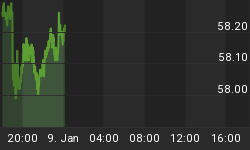One thing is certain these days. By sitting on my hands, I'm missing a lot of tradable swings! I am not too disturbed by this fact, since I am probably almost as likely to trade them poorly as well, but we are most definitely in a trader's market. Whatever your sense of the current economic environment makes you bullish or bearish, the value of corporate claims is not changing weekly by 140 S&P points. From the October 4th lows, stocks closed higher today by 12.4% (from the October 3rd closing low, the gain is only 9.8%!).
Are people really investing in this kind of crazy market? It scares me to death, and I'm a professional! (Then again, with all of the effort that officialdom has put into soothing us, perhaps it's only the professionals who are really scared.)
Intraday, the Dow erased its loss for the year before falling back. That sounds impressive until you remember that it was up 10% on the year as recently as July 21st. Volumes were fairly low and the Vix declined but remained above 31. 10-year Treasury yields rose to 2.21%, with 10-year TIPS yields at a hearty 0.23%. Copper and precious metals rallied; grains and energy declined.
The FOMC minutes from the September meeting were released today. There were some interesting items in there, aside from the somewhat crazy assertion that "most FOMC officials said inflation appeared to have moderated." (see Chart)

Moderating inflation, according to the Fed. This is core CPI, year-on-year.
Bad forecasts and weak monetary policy judgments from the Fed no longer surprise me, sadly, but two notes made me raise my eyebrows a little. Here is the first:
However, some others noted that a recent change in deposit insurance assessments had the effect of significantly reducing the net return that many banks receive from holding reserve balances.
This statement occurred in a discussion about whether interest on excess reserves (IOER) ought to be cut as a stimulative policy measure in order to spur bank lending (apparently they don't believe the hype about how there's just no loan demand). It is interesting because it implies that IOER has already been cut, effectively, and this in turn makes me more nervous about the recent rise in M2. For some time I've been suggesting that if the Fed wants to really add liquidity, it needs to eliminate IOER and that would tend to flush reserves back into the system. This snippet suggests that something similar has already happened. And that in turn increases the chances that the recent M2 rise is more than just a European deposit-flight one-off. I wasn't aware of the change in deposit insurance assessments and I don't know how large the change is, but the FOMC members appeared to think that it was enough to cause a meaningful change in the effective IOER realized by member banks.
The second item would have slipped past me if I hadn't just seen an interesting chart on the Fed's own home page. Here is the item from the minutes:
In secured funding markets, term financing reportedly remained readily available for both domestic and European financial institutions through repurchase agreements backed by Treasury and agency collateral. However, some strains emerged late in the intermeeting period in the market for repurchase agreements backed by lower-quality, nontraditional collateral.
And here is the chart:

![]() Larger Image - Borrowing strains are appearing in ABS. Source: Federal Reserve
Larger Image - Borrowing strains are appearing in ABS. Source: Federal Reserve
Lower-quality, nontraditional collateral like AA asset-backed lending, perhaps? I am not tied into the ABS market but I wonder if this isn't a warning sign for something bigger, like strains in the CMBS market for example (recall that the heads of the CMBS groups at Goldman and Citigroup both resigned the week of ... July 28th, and I noted it here. July 28th marked the point just before the first spike on this chart).
Some observers have been looking for an echo-blowup from the CMBS market for a long time after the residential MBS market took heavy fire in 2007-09. With everything that has been going on in Europe I haven't heard any developments recently, but this FOMC minute and this chart suggest that we should pay more attention. Owners of CMBS-backed paper ought to be looking quite carefully at their exposures not just to the underlying assets but also to the availability of financing on structure.
Tomorrow, a quiet data week continues with only Initial Claims (Consensus: 405k from 401k) on tap. Equities need to break higher fairly quickly, or the bearish crowd will team up with the range-trading crowd and push prices lower again. I'm rather in that camp myself. I am not concomitantly bullish on bonds, though. I would love to have the opportunity to get short 1.80% on 10-year notes again, because I missed it the first time (I judged it too early to be fading the strong seasonal pattern and have missed a 35bp one-way selloff since then), but I don't think that's going to happen. I'd be happy to sell some around 2.1% and scale into a short on a further rally, but I wonder if I will even get a chance to do that. I will probably use RYJAX, which is a single-inverse fund that doesn't have the return drag that a leveraged-inverse fund gets from volatility.
And come to think of it, maybe I'll start doing that right away in case I'm wrong about stocks!
















